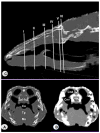Cranial Structure of Varanus komodoensis as Revealed by Computed-Tomographic Imaging
- PMID: 33918974
- PMCID: PMC8070356
- DOI: 10.3390/ani11041078
Cranial Structure of Varanus komodoensis as Revealed by Computed-Tomographic Imaging
Abstract
This study aimed to describe the anatomic features of the normal head of the Komodo dragon (Varanus komodoensis) identified by computed tomography. CT images were obtained in two dragons using a helical CT scanner. All sections were displayed with a bone and soft tissue windows setting. Head reconstructed, and maximum intensity projection images were obtained to enhance bony structures. After CT imaging, the images were compared with other studies and reptile anatomy textbooks to facilitate the interpretation of the CT images. Anatomic details of the head of the Komodo dragon were identified according to the CT density characteristics of the different organic tissues. This information is intended to be a useful initial anatomic reference in interpreting clinical CT imaging studies of the head and associated structures in live Komodo dragons.
Keywords: Komodo dragon; computed tomography; head.
Conflict of interest statement
The authors declare no conflict of interest.
Figures











Similar articles
-
The Komodo dragon (Varanus komodoensis) genome and identification of innate immunity genes and clusters.BMC Genomics. 2019 Aug 30;20(1):684. doi: 10.1186/s12864-019-6029-y. BMC Genomics. 2019. PMID: 31470795 Free PMC article.
-
Comparative evaluation of the cadaveric, radiographic and computed tomographic anatomy of the heads of green iguana (Iguana iguana), common tegu (Tupinambis merianae) and bearded dragon (Pogona vitticeps).BMC Vet Res. 2012 May 11;8:53. doi: 10.1186/1746-6148-8-53. BMC Vet Res. 2012. PMID: 22578088 Free PMC article.
-
MULTIHORMONAL ISLET CELL CARCINOMAS IN THREE KOMODO DRAGONS (VARANUS KOMODOENSIS).J Zoo Wildl Med. 2017 Mar;48(1):241-244. doi: 10.1638/2016-0131.1. J Zoo Wildl Med. 2017. PMID: 28363070
-
Biological Significance of the Komodo Dragon's Tail (Varanus komodoensis, Varanidae).Animals (Basel). 2024 Jul 23;14(15):2142. doi: 10.3390/ani14152142. Animals (Basel). 2024. PMID: 39123668 Free PMC article.
-
Blood values in wild and captive Komodo dragons (Varanus komodoensis).Zoo Biol. 2000;19(6):495-509. doi: 10.1002/1098-2361(2000)19:6<495::AID-ZOO2>3.0.CO;2-1. Zoo Biol. 2000. PMID: 11180411
Cited by
-
Anatomical Description of Loggerhead Turtle (Caretta caretta) and Green Iguana (Iguana iguana) Skull by Three-Dimensional Computed Tomography Reconstruction and Maximum Intensity Projection Images.Animals (Basel). 2023 Feb 10;13(4):621. doi: 10.3390/ani13040621. Animals (Basel). 2023. PMID: 36830407 Free PMC article.
-
Morphometric Study of the Eyeball of the Loggerhead Turtle (Caretta caretta) Using Computed Tomography (CT).Animals (Basel). 2023 Mar 10;13(6):1016. doi: 10.3390/ani13061016. Animals (Basel). 2023. PMID: 36978556 Free PMC article.
-
Anatomical Description of Rhinoceros Iguana (Cyclura cornuta cornuta) Head by Computed Tomography, Magnetic Resonance Imaging and Gross-Sections.Animals (Basel). 2023 Mar 7;13(6):955. doi: 10.3390/ani13060955. Animals (Basel). 2023. PMID: 36978497 Free PMC article.
-
Advances in Animal Anatomy.Animals (Basel). 2023 Mar 21;13(6):1110. doi: 10.3390/ani13061110. Animals (Basel). 2023. PMID: 36978650 Free PMC article.
References
-
- Deem S.L. Role of the zoo veterinarian in the conservation of captive and free ranging wildlife. Int. Zoo Yearb. 2007;41:3–11. doi: 10.1111/j.1748-1090.2007.00020.x. - DOI
-
- IUCN/SSC IUCN Red List of Threatened Species. [(accessed on 1 December 2020)];2002 Available online: www.redlist.org.
-
- Banzato T., Selleri P., Veladiano I.A., Martin A., Zanetti E., Zotti A. Comparative evaluation of the cadaveric, radiographic and computed tomographic anatomy of the heads of green iguana (Iguana iguana), common tegu (Tupinambis merianae) and bearded dragon (Pogona vitticeps) BMC Vet. Res. 2012;11:53. doi: 10.1186/1746-6148-8-53. - DOI - PMC - PubMed
LinkOut - more resources
Full Text Sources
Other Literature Sources

